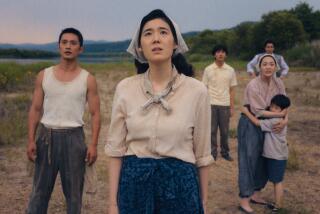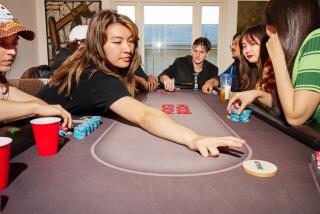Perils and Profits of Pachinko Passion
- Share via
TOKYO — Serene amid blaring music and the roar of steel balls clattering through hundreds of upright pinball machines, college student Aiko Takano sat happily with her boyfriend, licking a lollipop and losing money.
Takano, 19, was enjoying a Dutch-treat date at an upscale pinball parlor in Tokyo’s trendy Shibuya district, and her losses neither surprised nor bothered her.
She and her boyfriend play pachinko--Japanese-style pinball--about twice a week, she said, and lose about $800 a month. Her share eats up all she earns from a part-time job as a drugstore cashier, but she keeps coming.
New players like Takano--and seasoned addicts playing for rising stakes--have triggered the industry’s explosive growth in the last few years, despite Japan’s worst recession since World War II.
Gross revenue has doubled since the late 1980s, according to estimates by both the government and private analysts. It has hit $275 billion a year--more than the worldwide sales of Japan’s auto industry. After winnings are returned to players through a scheme exploiting loopholes in Japan’s anti-gambling laws, the industry’s take is about $36 billion.
In crowded cities short of recreation facilities and in country towns that may not even have a movie theater, the game offers welcome entertainment.
Its machines feature flashing lights, clanging bells and gaudy plastic flowers that open up with lucky hits to catch balls, or spinning rows of numbers that spit out winners, slot-machine style.
The game provides jobs for 320,000, including the likes of released criminals who cannot easily get work elsewhere. For most players, pachinko is a harmless pleasure that provides emotional release from stressful lives.
But even as pachinko has assumed a heavyweight role in Japan’s economy, a backlash of criticism has erupted against its negative social impacts: devastated family finances, broken marriages and highly publicized cases of unattended children dying from accidents or in the heat of parked cars while their mothers played pinball.
Between April 1995 and June 1996, according to a survey by the mass-circulation newspaper Mainichi Shimbun, 30 children died while parents played pachinko. They included several who were hit by vehicles in parlor parking lots and an unwatched boy who fell into a water-filled ditch.
The word “pachinkoholism” has been coined to describe the game’s addicts. Among the worst: a construction worker burdened by pachinko debts who robbed a Tokyo post office, then held a 2-year-old boy hostage for more than a day before surrendering to police and blaming his actions on the game.
Ironically, pachinko’s transformation from a small-stakes pastime into a serious form of gambling--the key to its huge expansion--was triggered largely by a botched attempt by authorities to exert greater control over the business.
A prominent fixture of Japanese society since shortly after World War II, the parlors long were viewed as unsavory, smoke-filled hangouts run by people who might have gangster connections. They were frequented mainly by harried middle-aged men who escaped their frustrations through the mesmerizing machines.
Pachinko still provides emotional release for “salarymen,” or workers at corporate offices, but it also increasingly draws homemakers and young couples.
In their bid to draw more women, many parlors put in love seats for couples and marked nonsmoking areas, a rarity in public buildings in Japan.
Aid for North Korea
The industry has long been notorious for tax evasion, gangster ties and the funneling of hard currency to the isolated and unpredictable Communist state of North Korea.
About 70% of parlors are owned by ethnic Koreans, including many who were born in Japan but retain South Korean or North Korean citizenship. Because Koreans in Japan have long faced discrimination in getting mainstream jobs, many entered businesses such as pachinko that were frowned on by society. Some send money to relatives in North Korea.
Estimates of annual remittances vary wildly--from about $100 million to several billions of dollars.
Many observers suspect that some of these funds flowed into North Korea’s nuclear weapons effort until that program was put on hold by a 1994 Washington-Pyongyang agreement.
Police launched their attempted crackdown a few years ago by offering parlor owners an implicit trade: permission to install higher-stakes machines in return for accepting the stricter financial controls of a system in which customers buy magnetic cards from an automatic dispenser, then insert them into machines to play.
These cards have proved a fiasco because of rampant forgery. But the money to be won or lost in a few hours has jumped dramatically.
Some machines using prepaid cards are set so that after a key win, the potential payoff is temporarily increased by 10 times, opening the possibility of winning more than $1,000 from a single jackpot--when the initial stake can be as low as $3.65. This can encourage winners who might otherwise quit while ahead to keep on playing.
The industry and authorities, however, still halfheartedly pretend that pachinko is not true gambling. Betting on horse, bicycle and motorboat races is legal, but gambling casinos are banned. To admit that pachinko is gambling would make the parlors illegal.
Almost no one wants that to happen: not the 30 million fans; not big-name companies such as Mitsubishi Corp. and Sumitomo Corp. that are trying to get a piece of the action, and not politicians, who receive campaign contributions from parlor owners and do not want to be accused of anti-Korean bias for shutting down the one industry where ethnic Koreans do well.
Thus the 18,000 parlors scattered across Japan survive as this country’s closest thing to Las Vegas-style gambling.
Losers in all this are people like Katsuyuki Hatakeyama, 23, a college student who had the misfortune several years ago of winning a few hundred dollars from a $5 stake.
“When I won money, I acquired a taste for it,” he explained. “I got hooked on it because of that. . . . When you’re playing the slot machine [one of the high-risk, high-payoff varieties], the sense of tension is a great feeling. Once you’ve experienced that feeling of suspense, you can never forget it.”
Though he now limits himself to playing once a week, Hatakeyama said he loses an average of $300 to $500 a month, or up to one-quarter of his living expenses. He gets about $1,000 monthly in support from his parents and earns an equal amount working part time as a waiter, he said.
Yasuhiro Kanno, a 17-year-old self-described “runaway” who is a year too young to play pachinko legally, is a victim in a different way: He is so skilled--or perhaps lucky--at the game that it has become his way of life. Most players and industry insiders say it is possible--though not easy--for players to put the odds in their own favor by studying the payoff patterns of different machines and picking the right ones to play. Kanno spends many hours doing just this.
Dressed in baggy black trousers and a gray plaid shirt, his long hair dyed reddish brown, Kanno said one recent afternoon that after just 30 minutes, he had turned an initial investment of about $4 into $110 worth of balls.
Flashing a self-satisfied grin and a wallet full of 10,000-yen notes (worth about $91 each), he said he won about $750 the previous day, from less than a $5 stake, and $900 the day before that. “I win almost every day,” he said.
Kanno said he is still in high school, has “lots of homes” because he sleeps at friends’ houses, and likes to “kill time” playing pachinko. Motioning to a sofa meant for couples, he said he recently spent much of a day sleeping there.
The dramatic growth made possible by players like Takano and Hatakeyama has taken the murky industry to unlikely heights.
“Now is a turning point,” said Han Chang Woo, 65, president of Maruhan Corp., which runs the fancy multistory Maruhan Tower that Takano and her boyfriend favor. “Pachinko parlors always had the image of gloomy places on back alleys that evaded taxes and had ties to gangsters. When I opened our pachinko tower in Shibuya last year . . . I pulled pachinko out from the back alleys and onto Main Street.”
Yoshifumi Nishiwaki, a Maruhan spokesman, said the firm mapped out its strategy to go upscale about five years ago.
“Pachinko took root as a kind of mass culture, but only for certain types,” he said. “It was a middle-aged man’s world that included scary-looking people. We decided that the future of this market was dim unless we attracted people who never played before. To do that, we needed to instill pride and motivation in the workers of this industry.”
Besides training employees to be more polite to customers and making parlors more physically attractive, leading pachinko firms started offering better-than-average salaries to college graduates and providing unusually good company housing for single employees in order to attract more professional management. Now a successful college-educated industry executive can earn as much as $100,000 a year before age 30, Nishiwaki said.
‘A Good Future’
Nobuki Kohara, a spokesman for T.J. Enterprises Inc., which started as a steakhouse chain, said his firm did market research two years ago to find an attractive new field to enter and decided on pachinko because it is “stable, profitable and has a good future.”
The firm now runs Jumbo Max, one of the fanciest parlors in Tokyo. Kohara is a symbol of the industry’s transformation: As a graduate of Tokyo University, Japan’s most prestigious school, he is the type of person who once would have been ashamed to work in the industry.
Pachinko has now grown so large that it has major ripple effects through the economy.
The industry spends $23 billion a year on parlor construction, new game machines, computer equipment to control the machines, prizes for winners and soft drinks sold within parlors, said Tetsuro Murobushi, a pachinko industry expert.
The idea behind the prepaid card system was that pachinko parlors’ profits could be monitored, correct taxes could be imposed, gangsters could be squeezed out of the protection-racket business, and pro-Pyongyang owners--who tend to be highly secretive about their activities--could perhaps be discouraged from sending funds to North Korea.
The only obvious catch was that the parlor owners did not want to install the new card-reading machines. They preferred to stick with cash-based business.
But police have enormous leverage over parlors because owners need police permission to operate. The police said, in effect: “If you agree to use prepaid cards, we’ll let you increase your jackpots.”
Fancy new machines that used prepaid cards and gave jackpots slot-machine style were soon installed widely.
Unfortunately for backers of the card plan--especially the big-name companies that made the cards--criminal gangs figured out how to make fakes that machines would mistake for the real thing.
When real cards are purchased, the money goes to the firms that make them, which in turn pay the parlors where the cards are used. But the legitimate firms could not distinguish whether used cards were real or fakes.
Parlors got reimbursed in either case, so they made out fine. The forgers got rich. And, this spring, the two card makers--Mitsubishi and Sumitomo--reported losses of about $575 million.
They are still trying to figure out how to beat the counterfeiters.
There’s little evidence of the card plan slowing the flow of funds to North Korea either.
Han, the Maruhan president, a South Korean citizen who has lived in Japan the last 50 years, said about 30% of ethnic Korean pachinko owners are linked to North Korea. Many of those with Pyongyang ties send money to North Korea not because they really want to, but because they feel pressure from the North’s representatives in Japan, he said.
“Everyone knows that some of the money has probably gone to North Korea’s effort to build nuclear weapons,” Han said. “Some pachinko owners linked to North Korea would like to cut those ties. But if they do, their relatives in North Korea will suffer. It’s as if North Korea is holding hostages.”
Meanwhile, though the total number of players is not growing, average losses for Japan’s 30 million pachinko fans doubled to about $1,200 for each player annually. About 87% of parlors’ revenues, according to industry officials and outside experts, is returned in winnings to players. This is done through a loophole in Japan’s anti-gambling laws. Successful players win buckets full of steel balls, which can be traded at the parlor for prizes such as cosmetics or cigarettes--but which are more often turned in for intrinsically worthless prizes such as little plastic boxes or cigarette-lighter flints.
The token prizes are then taken to a separate, technically independent establishment--usually a tiny hut--and traded for cash. These exchange centers sell the prizes back to the parlors, to be recycled.
Because these exchange centers hold lots of cash and generally operate in back alleys, they are especially vulnerable to protection-racket extortion by yakuza, Japanese organized-crime gangs. This has provided the yakuza with a key point of entry for broader influence in the business.
Part of the addictive nature of pachinko comes from the price and odds structure involving the machine balls. Customers pay about 4 cents for each ball, and on average end up winning back 1,400 balls for every 1,000 balls they buy. The typical player thus is a winner at the machine itself, at least in terms of steel balls. The catch is that when the balls are converted to cash by way of the token prizes and the exchange center, the player gets only about 2.5 cents for each ball. The way the odds work out, players lose about 13% of their money.
Because most players win balls, they may feel that they are ahead of the game--at least until they cash in and compare what they spent with what they won. Not all players even make this calculation.
Beating the Odds
These odds can be beaten through skill: not in how one plays when sitting at a machine, but rather in picking the right machines to play, based mainly on their recent payoffs.
Pachinko parlors, according to both industry insiders and frequent winners, regularly set some machines to let customers win, the better to attract players. The machines are said to be reset every few days, either electronically or by moving the small nails that the balls hit as they cascade toward target holes. Such adjustments usually are done overnight, most fans believe. Most serious players try to spot machines that have been giving a high number of jackpots, in the hope that they haven’t yet been readjusted.
Many players believe that the best odds come right after parlors install new machines, usually about once every three months. Kohara, the spokesman at Jumbo Max, said this is true. “People believe that, so if you don’t do it, they’ll be disappointed,” he said.
Yukihito Oba, 51, a small-business owner who has played pachinko since college, says that by visiting parlors and studying machines before playing, he does slightly better than break even. “When new machines are put in, you have to spend about a week watching which machines pay off well,” he said.
But Oba plays mainly to give his spirits a lift, not to win money, he said. “When you play pachinko, you think of nothing,” he said. “It’s good to have time like that.”
Megumi Shimizu of The Times’ Tokyo Bureau contributed to this report.


